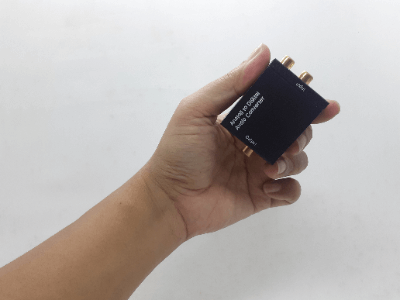What Is an ADC?

An ADC is a device that converts analog data into digital data.
Most information in the real world is continuous analog data, which must be converted into digital data expressed in terms of 0s and 1s to be processed by a computer. The opposite is called an ADC, which converts digital data to analog data.
ADC is available in various architectures (conversion methods) with different sampling rates and resolutions. Therefore, it is necessary to select the appropriate one according to the purpose.
Uses of ADCs
ADCs are used in numerous applications in our daily lives. Specifically, they are used in digital cameras and audio equipment. They convert analog data such as video and sound into digital data for output.
Various electronic devices need to use analog signals as input information, but the internal processing is done with digital signals. Therefore, ADCs are required. ADCs are installed in devices that handle light, temperature, etc.
High-speed ADCs with high sampling rates are being developed for digital cameras and audio equipment, which require high-speed transmission.
Principle of ADCs
The conversion of analog data into digital data by ADCs is divided into three major stages.
- Sampling is performed by periodically cutting out a continuous analog signal.
- Approximating the amplitude of the sampled signal to a discrete value is done.
- Encoding is performed to represent the approximated signal in binary 0s and 1s. The circuit that performs the encoding is called an encoder.
Sampling rate and resolution are indicators of ADC performance. The sampling rate represents the speed of conversion; the higher the value, the faster the conversion.
Resolution is an indicator of how finely the data can be expressed and is expressed in bits (the number of binary digits in the encoding). The higher the value, the smoother and more accurate the representation.
There is a trade-off between sampling rate and resolution, whereby resolution is sacrificed for high-speed sampling, while a slower sampling rate is required to achieve high resolution.
Other Information on ADCs
1. Resolution of ADCs
The resolution of ADCs are concept of how finely the input analog signal can be quantified. The unit is expressed in bits, where 8-bit data is broken down to the eighth power of 2 and expressed as a number from 0 to 255. In general, the number of bits is often a multiple of 8.
If the analog input is a number from 0 to 2 and the ADCs have an 8-bit resolution, then 2/(2^8-1) = 2/255 = 0.007843. From the above, the minimum resolving power of an 8-bit-ADCs that can input from 0 to 2 is 0.007843. As high-precision ADCs, 32-bit, and 64-bit products are in practical use.
2. Sampling rate of ADCs
In ADCs, the sampling rate is an important index as well as resolution; the sampling rate of ADCs is how often it samples an analog quantity. This is the speed at which the Analog-to-Digital converters operate.
By the Nyquist Theorem, we know that ADCs require a frequency that is at least twice the frequency of the input analog signal. Therefore, the sampling rate of the ADCs is set to 2.2 times or more than the input analog signal frequency.
3. Accuracy of ADCs
ADCs are subject to errors. For example, a 16-bit ADCs with an analog input of 0 to 2 has an error of 2/(2^16-1)=0.0000030518. The degree of accuracy at which sampling is required is determined by the above calculation.
It is important to note that the performance of the ADCs does not always directly translate into the performance of the device; input protection circuits, amplifiers, attenuators, etc. are provided before the input terminals of the ADCs, where minute signals are handled.
If the peripheral circuits of the ADCs are not carefully selected, the performance of high-precision ADCs may not be fully demonstrated.